Learn how to make fresh paneer at home with only a few simple ingredients. This easy homemade paneer recipe creates the softest, most tender paneer cheese from scratch – with no preservatives or special additives needed.
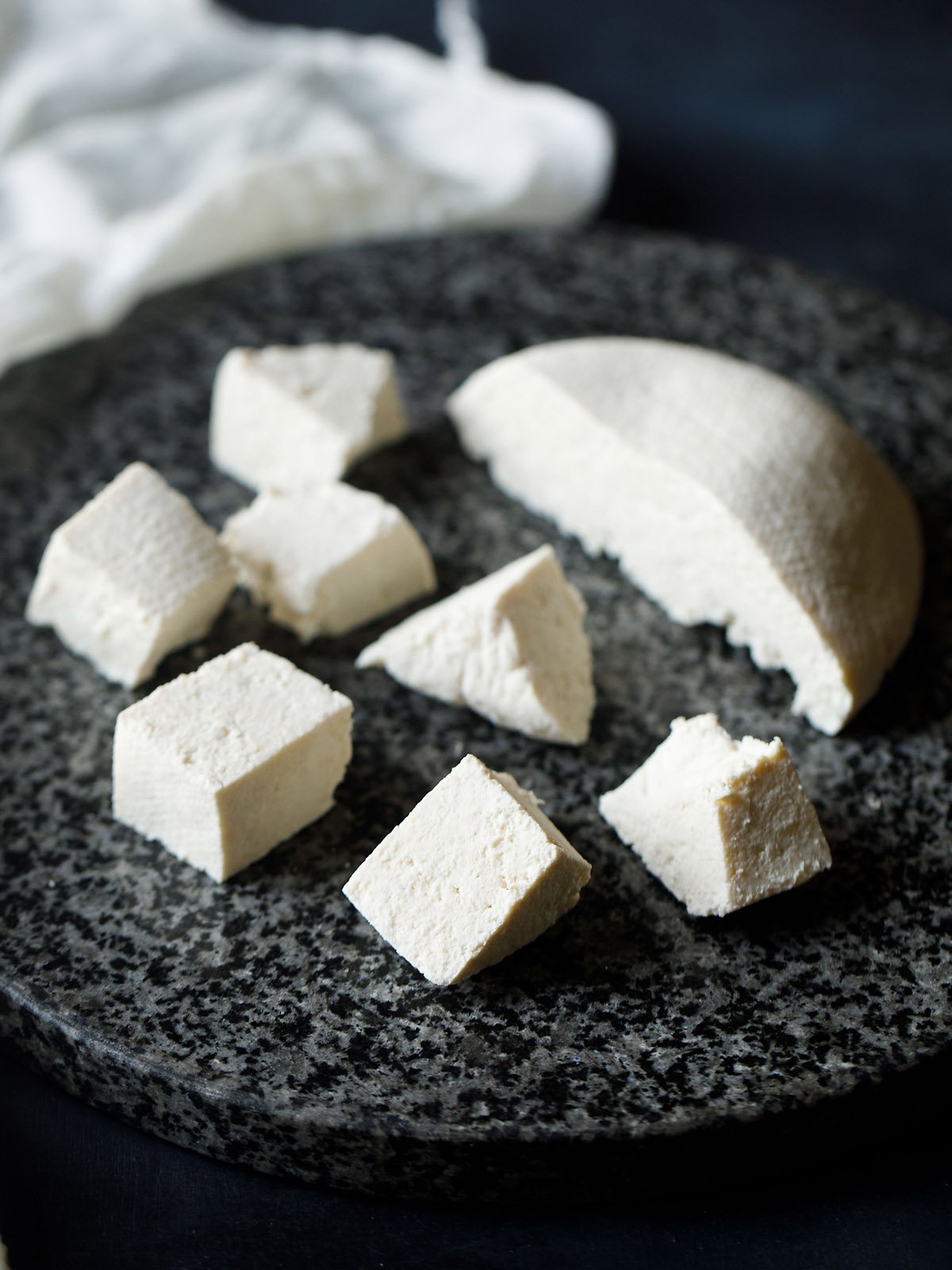
I have been making paneer from scratch for many years, and cannot remember the last time I bought it in a store. Not only is homemade paneer more wholesome and fresh, it is actually cheaper to make than it is to buy.
With just a few key steps and tips you too can make the best tasty paneer in your own kitchen!
What is Paneer?
Also known as Indian cottage cheese, paneer is a fresh cheese made by adding a food-based acid to curdled milk. The resulting whey is strained and pressed in muslin cheesecloth, creating a firm block of delicious cheese.
Paneer does not require any fermenting or curing. And unlike many other kinds of cheese in the world, the making of paneer does not involve Rennet, and it is therefore completely vegetarian-friendly.
It is a firm, non-melting cheese that is unsalted, and has a pleasantly mild flavor. Paneer cheese is made in a similar way ricotta cheese is made.
Blocks of homemade paneer can be used to make a variety of tasty dishes, from pakora to curries – and is super yummy to eat by the slice on its own!
About Homemade Paneer
I learned how to make paneer decades back in my cooking school. It is a simple process that involves first boiling milk and curdling with a food acid, then pressing to form a firm cheese.
The curdled milk is strained and pressed in cheesecloth, and the whey is either discarded or reserved for later use.
After just 30 minutes you have a beautiful homemade block of fresh homemade paneer that’s ready to keep in the fridge or use in your favorite dishes.
5 food acids that curdle milk
- Lemon juice or lime juice: Adding lemon juice gives a soft and firm texture to your homemade paneer. For a litre of milk you could add about 2 to 4 teaspoons of lemon juice depending on the quality of milk.
- Vinegar: A firm and soft texture is also achieved by adding vinegar. Add about 2 to 3 teaspoons of white vinegar or apple cider vinegar in 1 litre milk. With vinegar the milk curdles faster and quicker.
- Curd or yogurt: Fresh curd will give you more softer and moist paneer. You could add about 3 to 4 tablespoons of fresh curd or yogurt when making paneer recipe with 1 litre milk.
- Buttermilk: Using buttermilk also yields a soft as well as firm paneer cheese. Try adding 4 to 5 tablespoons of buttermilk in a litre of milk.
- Citric acid: I do not use citric acid as it create too firm of a cheese. But you can try it in combination with lemon juice or vinegar.
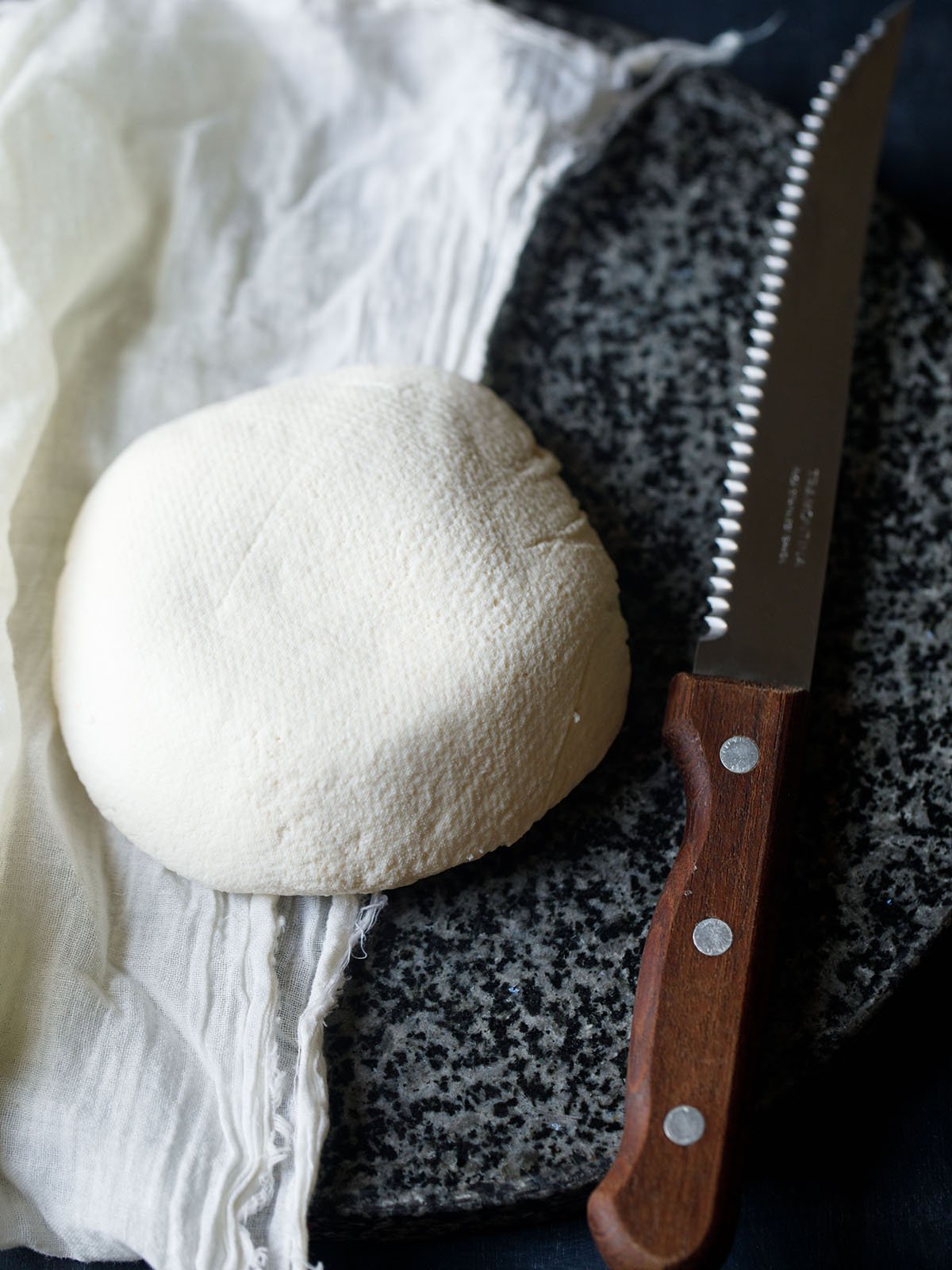
How to Make Paneer
Boiling the Milk
1. First, rinse a large, heavy duty pot with water to ensure that it is completely clean. Add 1 litre (approximately 4 cups) of milk to the pot.
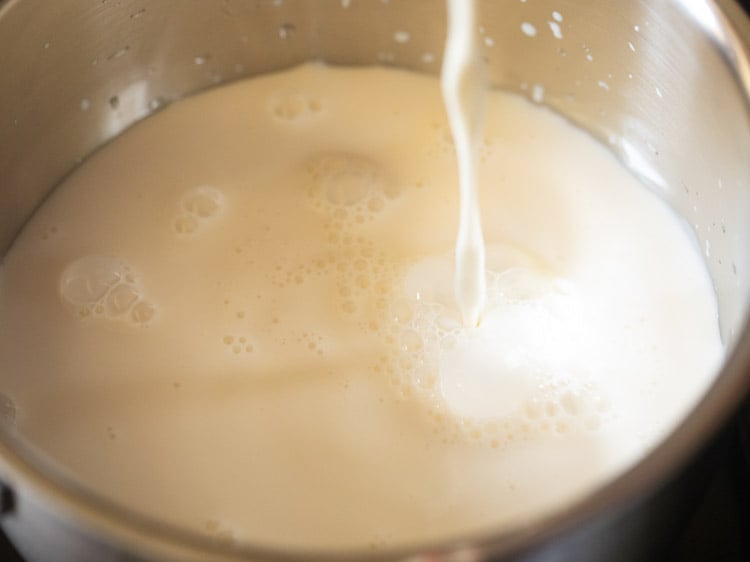
2. Then begin to heat the milk on a medium-low flame.
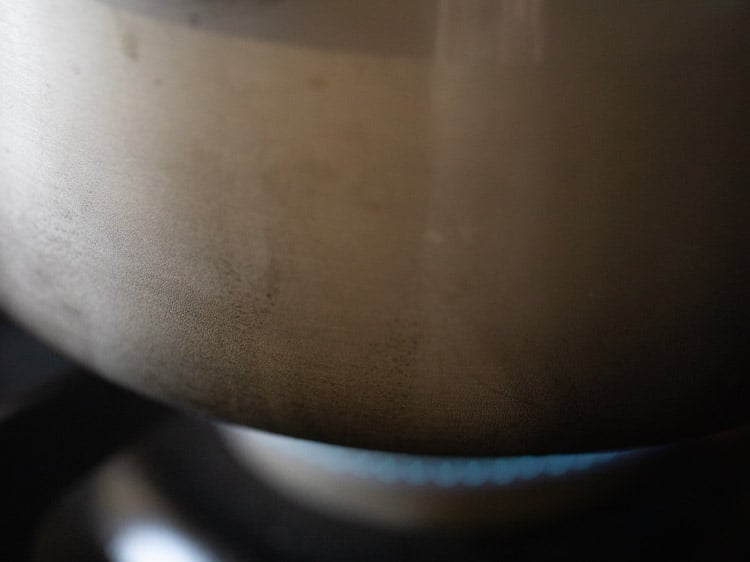
3. As the milk heats, stir occasionally so that a skin does not form on the surface and the milk does not burn on the bottom of the pot.
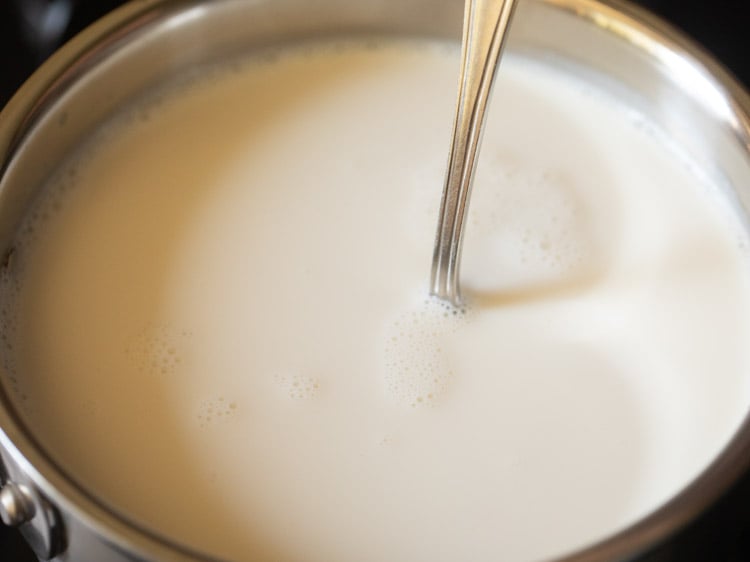
4. Meanwhile, prep your workspace: Place a metal strainer or sieve over another large sauce pot. Then line the strainer with clean muslin or cheesecloth, or a cotton napkin.
You can line the pan directly with the muslin, but using a strainer is very helpful for avoiding messes.
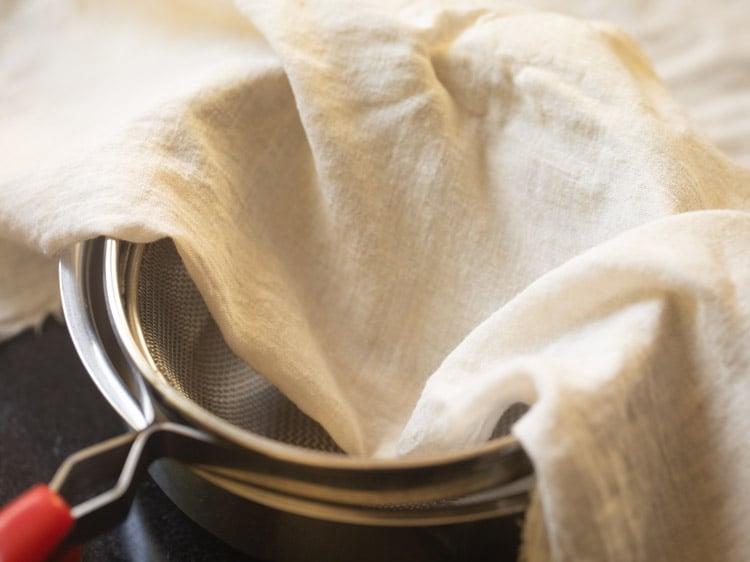
5. Let the milk come to a boil, until it starts foaming and rising.
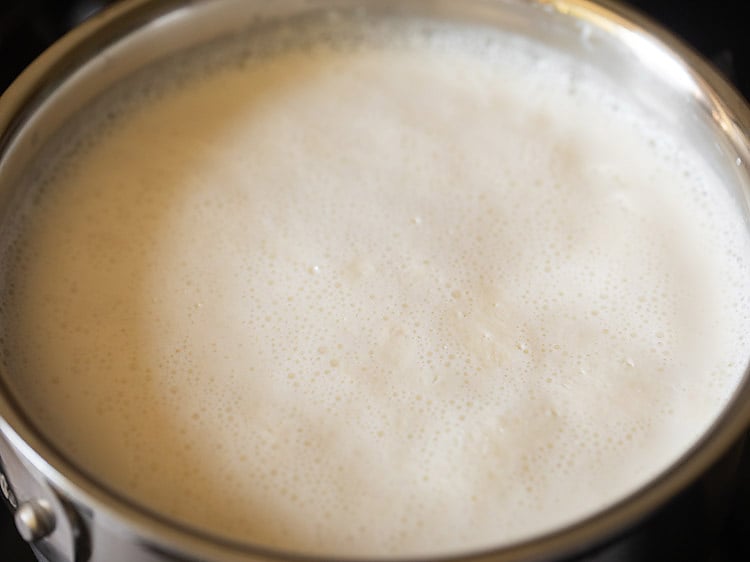
Adding Food Acid
6. Now it’s time to add the one food acid of your choice:
- Lemon juice – 2 to 4 teaspoons
- Vinegar – 2 to 3 teaspoons
- Buttermilk – 4 to 5 tablespoons
- Curd – at least 3 to 4 tablespoons
The amount of acid needed will depend on the quality of milk used. More fat in the milk will require more food acid to make this paneer recipe.
For this batch of paneer I am using lemon juice as the acid. It’s my favorite for its mild flavor and freshest tasting cheese.
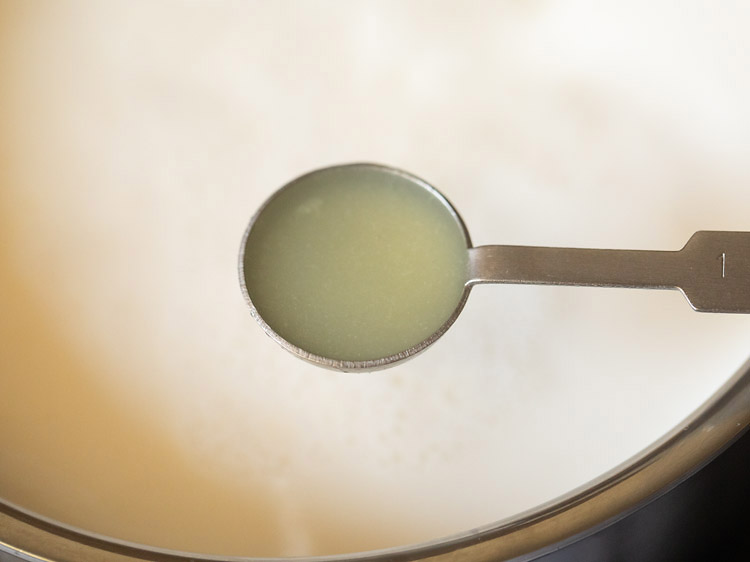
7. Stir in the lemon juice (or acid of choice). The milk will begin to curdle immediately.
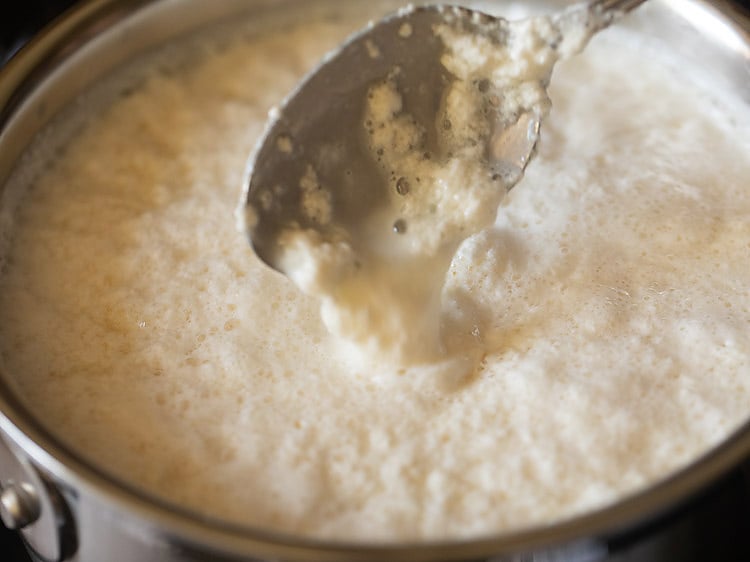
8. The milk must curdle completely before you can make paneer. Continue to stir the milk to help keep it from sticking to the pot.
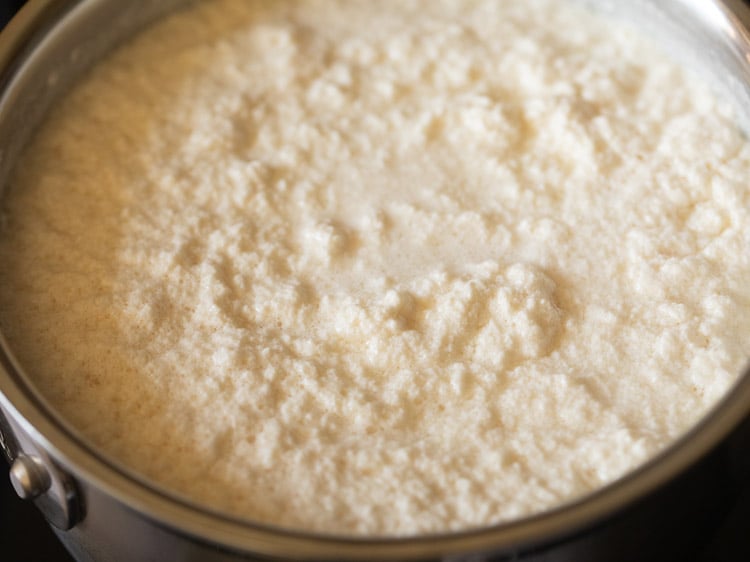
9. Add 1 to 2 teaspoons more of the food acid if it doesn’t seem to be curdling fully.
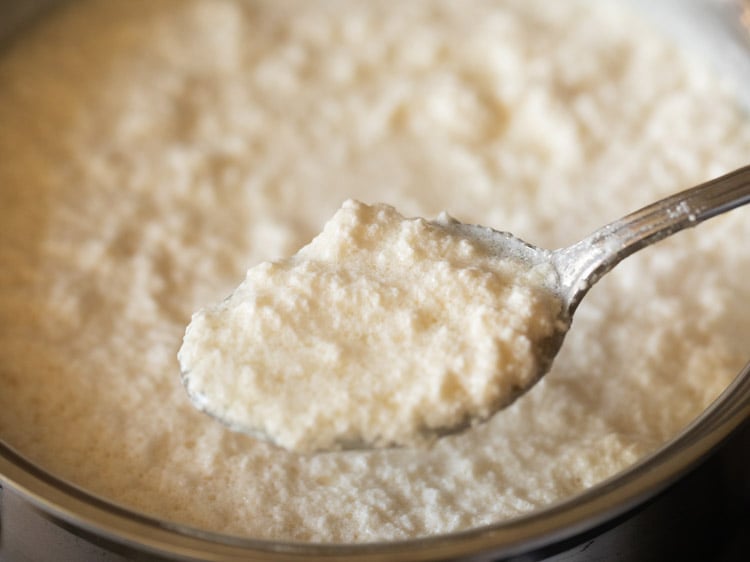
Making Homemade Paneer
10. After the milk has fully curdled completely and you see a greenish whey, switch off the heat. Then immediately pour the mixture into the lined strainer.
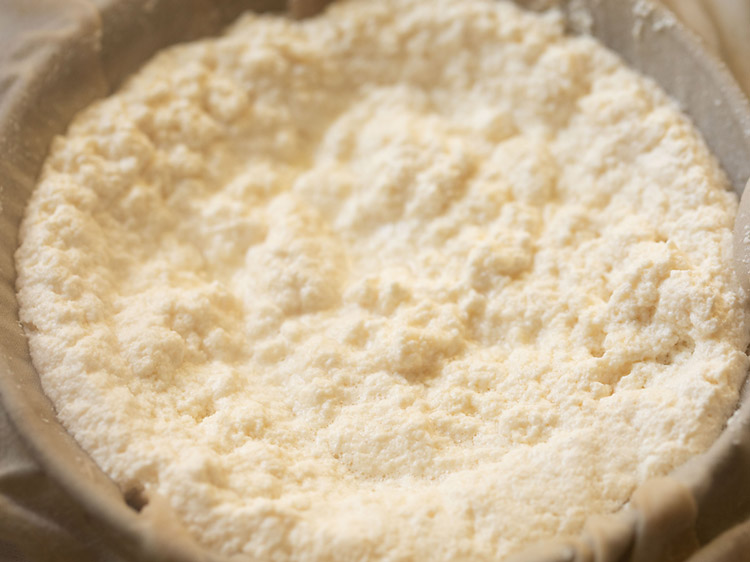
11. Next, gather the edges of the cheesecloth – be careful, the coagulated milk mixture will be very hot. Lift the bundle and allow to drain until no longer dripping.
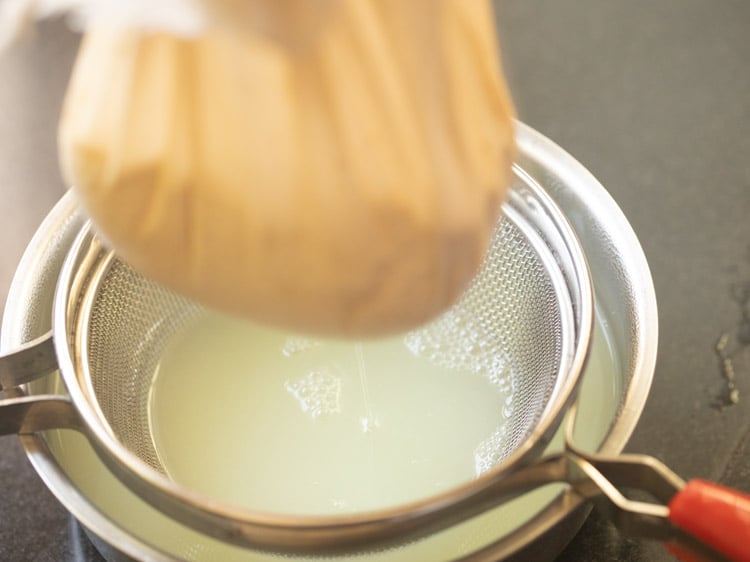
12. With the ends tightly gathered, run clean, fresh water all over the cloth to rinse. This ensures that the lemon or vinegar flavors are also rinsed with the water. If you have used curd or buttermilk, then you do not need to follow this step.
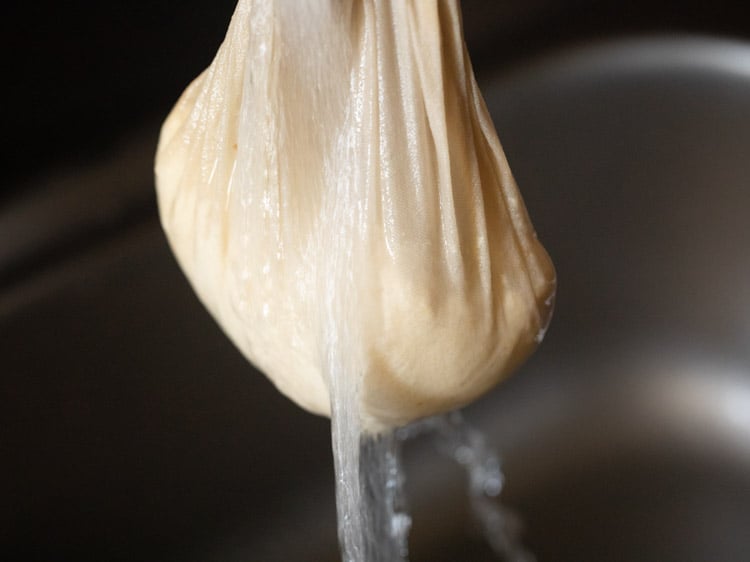
13. Tightly secure the ends of the cloth to keep the chenna wrapped, then place the bundle back in the strainer on a plate or over a clean bowl.
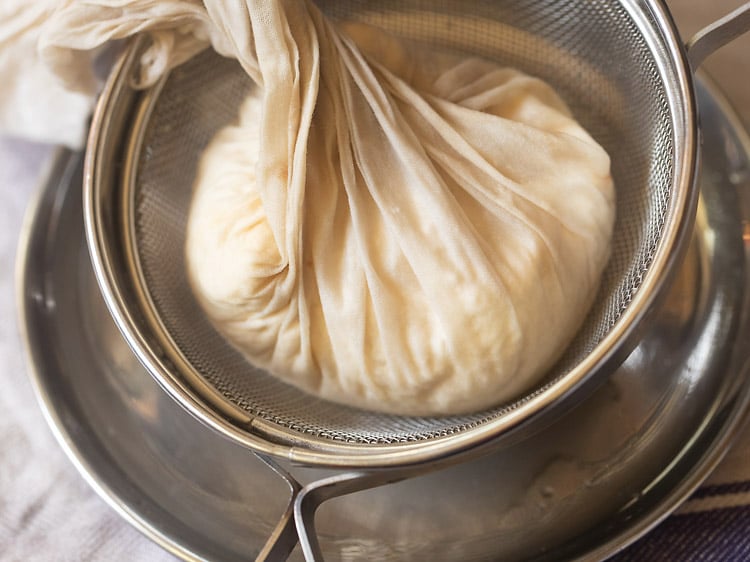
14. You can either hang the bundle (on your kitchen basin faucet) or press to form the cheese. Hanging the bundle will require about an hour, and should be done over a bowl or in your kitchen sink. This method tends to produce a softer, more loose texture.
I prefer to make a firmer paneer cheese by pressing the whey out with an object that weighs at least 500-600 grams (or at least 1 pound). This method only requires 30 to 40 minutes and can be done in the strainer over a pan or bowl.
In the picture below I’ve used the mortar from my mortar and pestle set. You could even stack up with some plates.
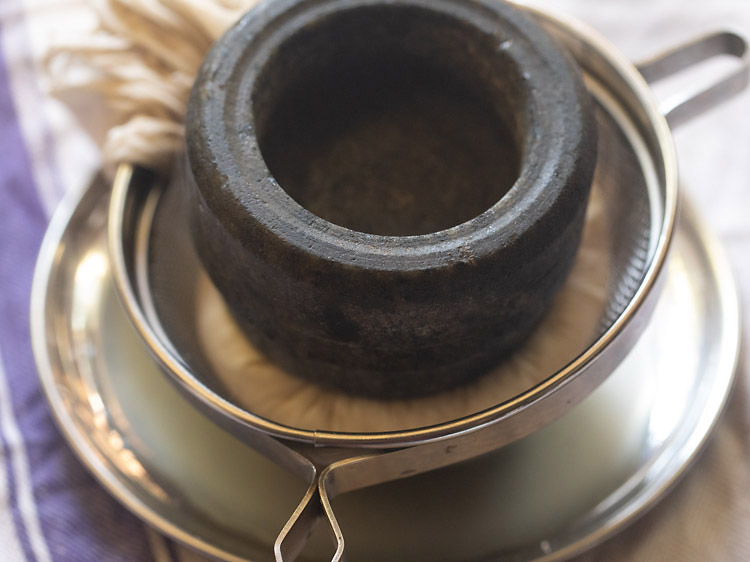
15. After 30 to 40 minutes of pressing the paneer is ready. The longer it sits with the weight the firmer your cheese will be. So for a softer cheese be sure to take off the weight sooner rather than later.
Remove the weight and open the cloth. I used one litre (4 cups) of milk and therefore made roughly 200 grams, or 7 ounces, of homemade paneer.
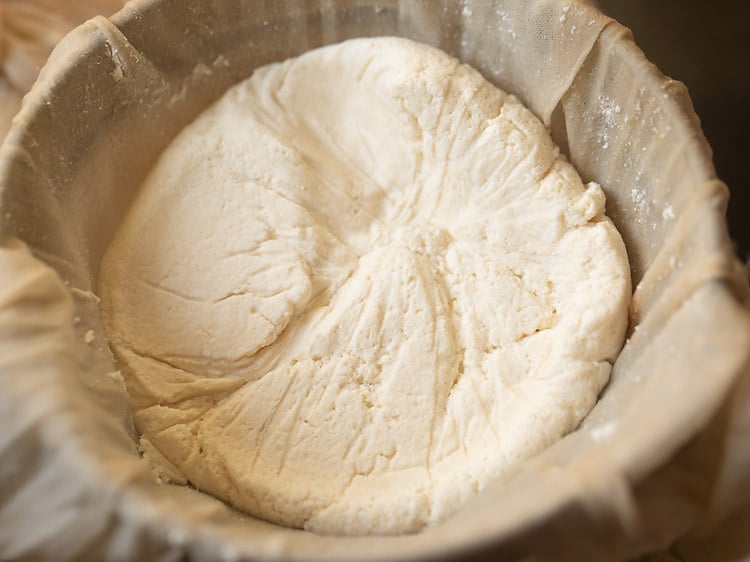
16. You now have a beautiful block of smooth and tender paneer cheese.
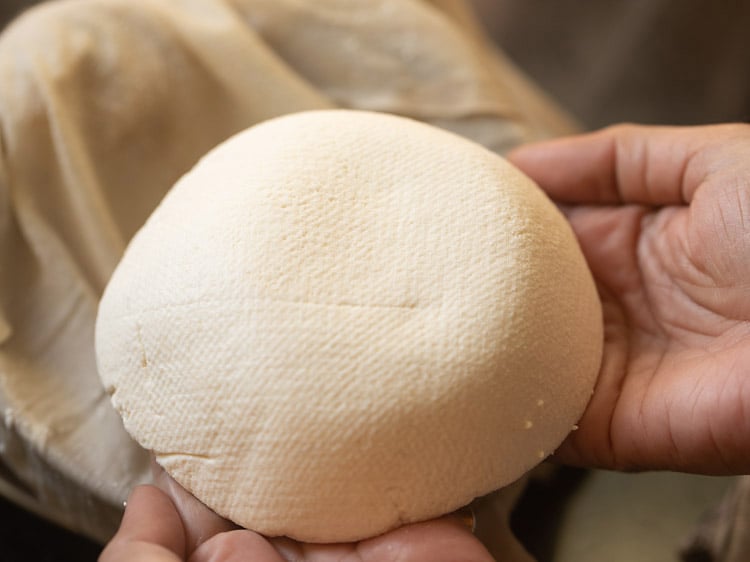
Storing and Using Paneer
17. Use the paneer right away to cook, or you can refrigerate it for later. To refrigerate, keep stored in an airtight container for 2 to 3 days.
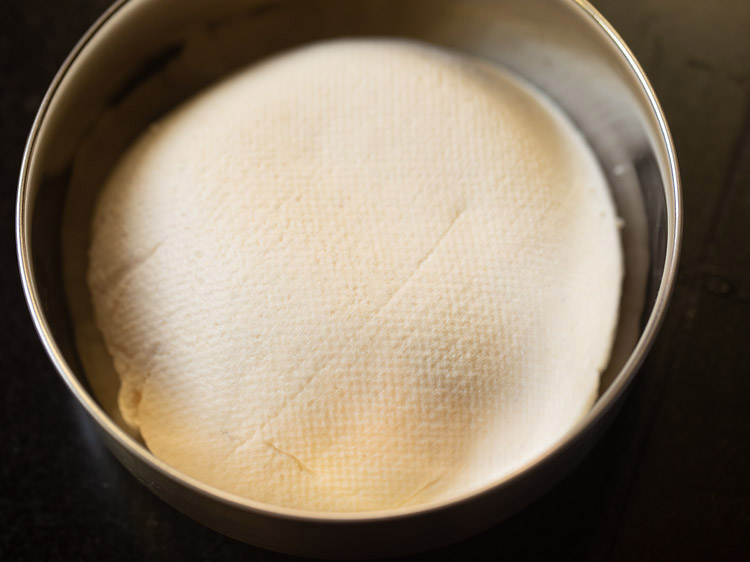
18. The collected whey can be added to roti, rice or vegetable dishes. Keep reading for some great ideas of what to do with the whey!
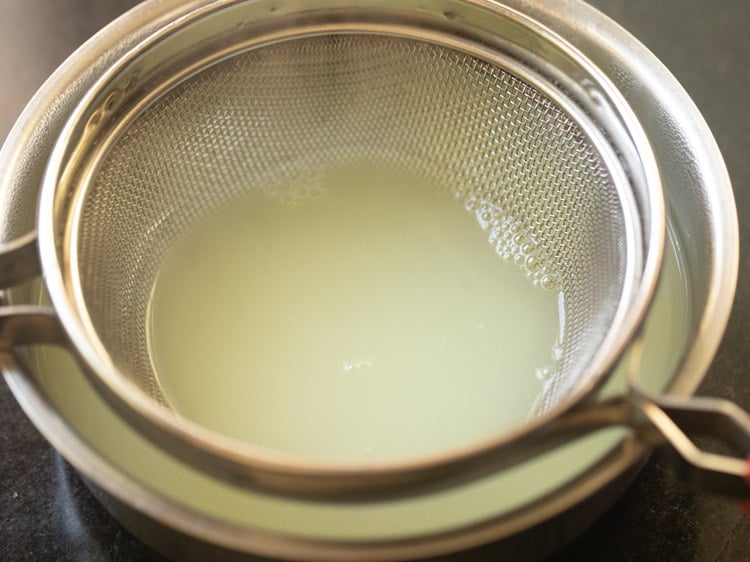
19. When ready to use the paneer, slice it thin or chop into chunks – whatever your recipe calls for. Try your fresh homemade paneer to make your favorite Indian curries or you can check my category of Paneer Recipes for more ideas.
You could also make Kadai Paneer, Palak Paneer, Paneer Butter Masala, Paneer Tikka, or any number of delicious recipes.
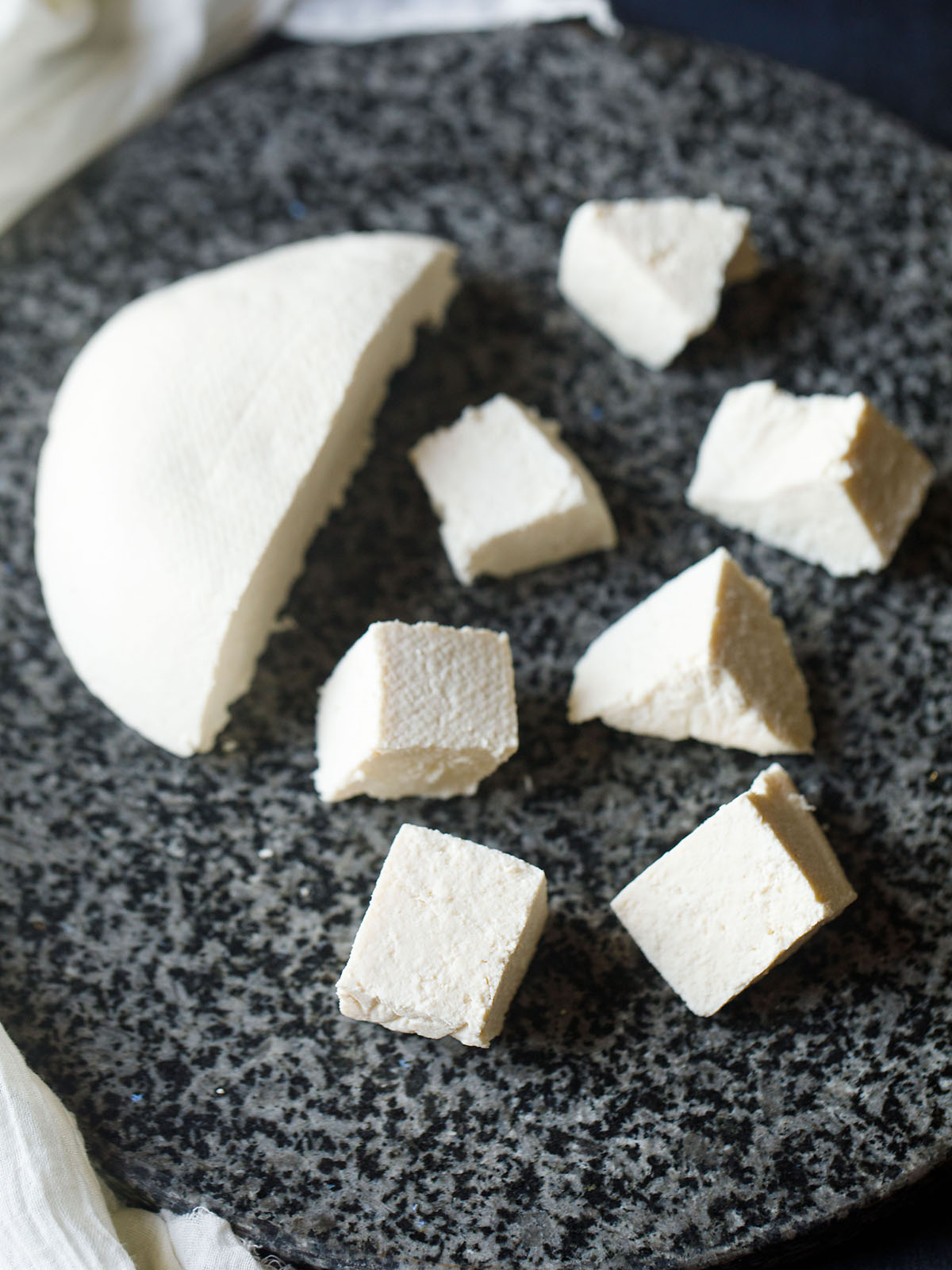
What to do with Leftover Whey
After pressing or hanging the paneer, you’ll have a greenish colored whey which is very rich in nutrients. You can discard this liquid, but I highly recommend you keep and use it for adding a healthy boost to a number of recipes. Easily refrigerate the whey for up to 5 days in an airtight container.
However, it should be noted that there will be a hint of flavor in the whey from whatever food acid agent is used. For example, if lemon juice has been used to curdle milk, there will be a bit of sourness in the whey and therefore any dish made with it.
Here are just a few ways to use the whey from the paneer-making process:
- Add nutrient-rich whey into the dough of breads like chapati, paratha, or any baked loaf of bread!
- Mix it into cake batters or cookie doughs.
- Include the whey in dals such as Dal Fry or Dal Tadka.
- Even Pulao and Biryani taste good with the whey added! If using to make veg biryani, add the whey in the vegetable gravy instead of water.
- Whey can be added raw into fruit smoothies, juices and even soups.
- It can also be added in any gravy or curry as a substitute for water.
- You can even make pasta based dishes with the whey!
- Because it is so rich in nutrients, you can even use it to nourish houseplants or garden plants! Simply cool and mix with water before watering your plants.
Expert Tips
Want to make sure your paneer is perfect every time? Be sure to follow my tips:
- Milk: For the tastiest paneer I recommend using full fat whole milk. Pasteurized or unpasteurized is fine, but it should be high quality for the best results. Do not use toned or skimmed milk for making paneer. Without lots of fat the paneer cheese will come out far too hard. Always use fresh milk that is not expired.
- Food acid: You can use any one of the four ingredients that coagulate the milk as mentioned above, but remember: each of these will add a hint of flavor to the paneer. Therefore use buttermilk or curd to make paneer with the most mild flavor.
- Cream: There is no need to remove any cream that you might see floating in the milk as it cooks. In fact, the natural cream present in the milk is what makes the paneer soft. Additionally you could add 2 to 3 tablespoons heavy cream in the milk before heating which will make for a more softer paneer.
- Simmering: Do not continue to boil the milk once it curdles completely. Immediately remove it from the heat and strain the milk. Otherwise, overcooking will yield an unpleasantly hard, crumbly cheese.
- Storing: Keep the paneer soft in the fridge by placing in a bowl and soaking the paneer block in water. If the paneer does become hard you can soak the block in warm water for a minute or two on the countertop.
FAQs
Firstly use whole milk or full fat milk when making paneer recipe. Paneer made with toned milk or skimmed milk or low fat milk breaks while cooking and does not set well. Do make sure that you drain the whey very well. Keeping paneer in the fridge also helps to firm it.
Freeze paneer for a month or two. While defrosting keep the paneer in warm water or let it defrost at room temperature. Yes paneer does work well after defrosting.
Yes, absolutely.
If there is more fat content in the milk, you will need to add more lemon juice to curdle it. So continue to add in parts and stir until you see that the entire milk has curdled.
If you continue to simmer the milk after it is curdled for some seconds or a minute, then the paneer becomes grainy and crumbly. Adding too much of lemon juice or vinegar will also make the paneer crumbly or granular.
Though they both look same and are made in a same way, they are different. Chenna is the coagulated milk shreds and paneer is the coagulated milk which has been set firmly. Chenna is more moist than paneer. You can check my Chenna Recipe.
If the right amount of lemon juice is added, it just takes some seconds for the milk to curdle.
Popular Recipes with Homemade Paneer
Paneer Recipes
Paneer Recipes
Paneer Recipes
Snacks Recipes
Please be sure to rate the recipe in the recipe card or leave a comment below if you have made it. For more vegetarian inspirations, Sign Up for my emails or follow me on Instagram, Youtube, Facebook, Pinterest or Twitter.
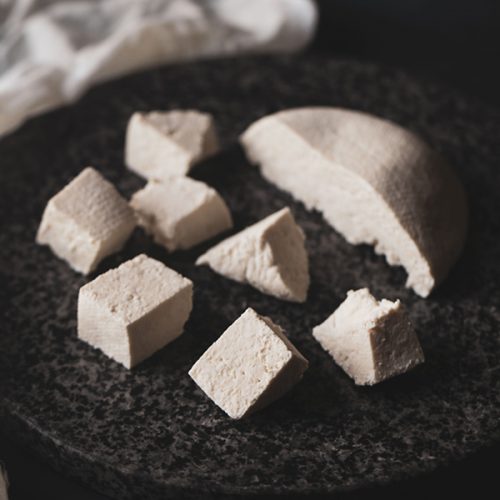
How to make Paneer at home from scratch
Ingredients
Ingredients
- 1 litre full fat whole milk
- 2 to 4 teaspoons lemon juice or vinegar or 3 to 4 tablespoons curd or yogurt
Materials required
- cheese cloth or muslin or a thin cotton napkin
- some bowls and a heavy weight object or plates
Instructions
Boiling milk
- First, rinse a large, heavy duty pot with water. Add milk to the pot.
- Then begin to heat the milk on a medium-low heat.
- Stir occasionally so that the skin does not form on the surface and also so that the milk does not get burnt from the bottom.
- Meanwhile, take a pan or a bowl. Place a strainer on the pan. Line the strainer with clean muslin or cheesecloth or cotton napkin. You can even line the pan directly with the muslin.
Adding food acid
- When the milk starts boiling, add the lemon juice or vinegar. Begin to stir.
- The milk has to curdle completely. Stir the milk when it is curdling so that the curdled milk does not stick to the base of the pan.
- Sometimes you will see the milk has curdled partly but no watery whey can be seen. In this case also add 1 to 2 teaspoons more of the food acid and stir again. You should see the greenish colored whey in the milk.
- After the milk has curdled completely and you see the greenish whey, switch off the heat and then immediately pour the entire mixture in the strainer lined with the muslin, cheesecloth or cotton napkin.
- Carefully gather the edges of the muslin as the coagulated milk mixture will be very hot. While doing this more of the whey will be strained.
- Run some clean fresh water on the gathered muslin all over.
Making paneer
- With the ends tightly gathered, run clean, fresh water all over the cloth to rinse.
- Keep a heavy weight on top of the muslin or cheesecloth for 30 to 40 minutes. Use a heavy object having 500 to 600 grams weight. You can even hang the muslin bundle for an hour on your kitchen basin faucet if not using a heavyweight object.
- Some more whey will be strained when you place the heavyweight object. So remove the whey from the plate.
- After 30 to 40 minutes the paneer will set.
- Once warm or cooled cut homemade paneer into cubes or any shape.
- You can also refrigerate the paneer. Keep it in an air tight container or immerse the paneer block in a bowl of water and keep in the fridge.
- Homemade paneer stays fresh for 2 to 3 days in the fridge in an air-tight container. You can slice the paneer cheese later and use it any recipe.
Video
Notes
- Milk: First and foremost use good quality milk. Again full fat whole milk yields excellent results just like it does for making homemade curd. You can use both raw milk or homogenized milk.
- Food acids: Three ingredients that coagulate the milk. You can use any one of them: Lemon juice, curd or vinegar. Each of these will add a faint hint to the paneer you make. Remember this. If you don’t like lemony or vinegar taste, add curd (yogurt) or buttermilk instead.
- Cream: If there is plenty of cream floating on top of milk surface, then there is no need to remove it. The natural cream present in the milk, makes the paneer cheese soft.
- Curdling milk: When you add the lemon juice or vinegar the milk will begin to curdle. The milk has to completely curdle. You should be able to see the whitish or greenish whey. When the milk has curdled completely then do not simmer or cook it further. Remove immediately and strain the milk. This overcooking will yield a hard paneer when it is set.
- Storing: Refrigerate paneer in an air-tight container for 2 to 3 days. Another way to keep the homemade paneer soft in the fridge is to soak the paneer block in water in a bowl and keep in the fridge. This way the paneer does not become hard. Alternatively you can soak the paneer in warm water after you have removed it from the fridge.
- Scaling: You could easily make a large block of paneer by doubling or tripling this recipe. When the paneer is set, chop them in cubes. Place them in an air-tight box and freeze. You can even refrigerate the paneer cheese for 2 to 3 days.
Nutrition Info (Approximate Values)
This homemade paneer recipe post from the archives first published in May 2012 has been updated and republished on November 2020.
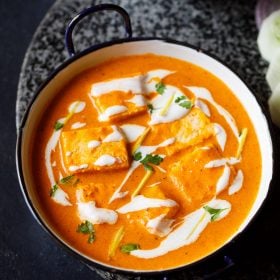
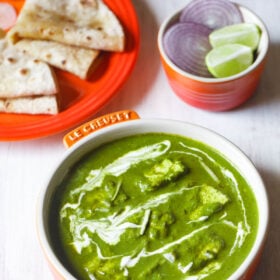
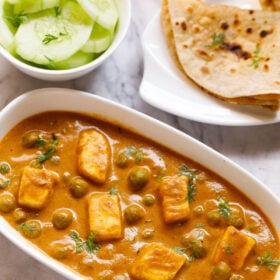
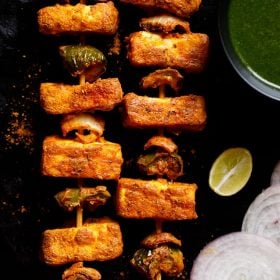

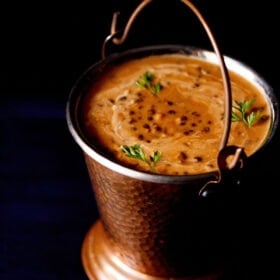
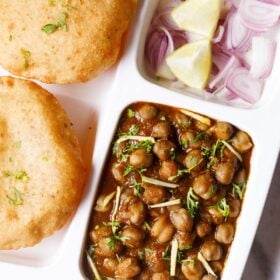








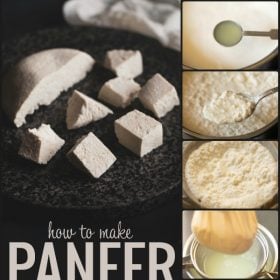
Thank you for this and all other recipes. I am a regular reader of your recipes and the effort you put into description is laudable. I always search on this site for the recipe I want and follow your instructions. The alternative options you give are also very useful and practical.
thank you piyush. glad to read your comment. thanks again.
I tried making paneer for years. But I never succeded in making it with lemon.
I used a chemical acid (allumen) before but I had the impression it was not totally good for health.
Your recipe is fantastic. I never had better paneer than this one. The description is perfect. I am so happy to have paneer again… now I can try all your wonderful recipes with it. Thank you!
thanks sabrina for the sharing this as well as the rating. yes sure do try the recipes.
Hi Dassana,
Thanks for this and your entire archive of wonderful recipes. I love how you curate recipes from all over India! One question: how does this paneer stay firm when it’s fried in a recipe like kadhai paneer? Mine tend to disintegrate. Thanks!
gitanjali for making paneer, use full fat or full cream or whole milk. do not use toned milk or low fat milk as the paneer breaks while cooking and also does not set well. the paneer cubes in the post were made from full fat milk and even after frying they stay firm.
Hi Dassana,
Your website is wonderful and so inspirational!!. I spend a lot of leisure time browsing through.
Thanks
Anu
Welcome Anu. Glad to know this.
Hi Dassana,
How long does paneer stay good frozen?
Thank you.
Anu
Welcome Anu. Frozen paneer can stay well for a month.
Can I use diz fr making paneer gulab jamun
Revathy, yes you can use.
Hi Dasana
Thank you for your super easy recipes. I have tried many and they have turned out really well.
But I could never see whey forming when I make paneer. I made it more than once. It came fine. But once I add lemon juice. I keep stirring it till the milk reduces in volume afraid it might stick at the bottom.
When I add lemon juice the milk curdles but I can only see small parts separating. I cannot see whey separating as you show in the picture.
For 30 mini just keep stirring the milk. But you mentioned only 5 min to completely curdle.. what is the mistake?
welcome bhargavi. this is happening due to the fat content in the milk. use full fat milk. do not use skimmed or toned milk. in fact it takes just ½ to 1 minute for the milk to curdle. in case the milk does not curdle, then add some more lemon juice.
Have you tried freezing this?
Does it work well after defrosting? Thank you!
you can freeze paneer. you can keep the paneer in warm water for defrosting or let it defrost at room temperature. yes paneer can be used well after defrosting
Dear Dassana!!
Thank you, thank you, thank you!! 🙂 Your recipes are easy to follow and the food becomes yum and makes me feel im back in India!
I found your website 3months back when i was searching for an aloo baingan recipe. I had enjoyed what I had eaten at a restaurant here in Auckland and kept asking who ever was serving if they knew what was in it 🙂 I love food and I love experimenting. And I found your easy peasy recipe and it was a hit! I have used your website to make different dishes.. And i just made paneer using your recipe! 🙂 🙂 🙂
Keep up your awesome work and thank you for sharing your awesome recipes and tricks and tips of making yummy food! God bless!
Welcome Christina. Thanks for your kind words and best wishes. Glad to know that you liked the website.
This site is very useful and easy to follow steps
Thanks Gomathi
Hello..
I tried to make paneer many times but it was never upto my expectations. I used this method and i got a very good block of soft paneer. Thanks a lot for solving our kitchen problems. I want to know the shelf life of this paneer block and please do mention the method too. Thanks once again.
Welcome Bhavna. Glad to know this. In the refrigerator, Paneer will stay good for 3 to 4 days. Just keep it cover in the container while keeping in fridge.
Is this muslin cloth or something specific? ? I have muslin cloth but paneer doesn’t come out clean when I drain the water. Thanks for your help!
i use muslin for straining paneer and even for preparing hung curd. use a finely woven muslin. in these pics its a cotton kitchen towel. so you can use either a cotton kitchen towel or a finely woven muslin.
Hi Dassana, May I know where you bought your muslin cloth from? The one I’ve got is not as good. Thanks ?
Welcome Ranjini. I bought it from a local clothes shop.
First, I’m loving this website. I’ve made several recipes and have loved EVERYTHING! Regarding paneer, in the U.S. we use ounces, quarts, and gallons. Would a liter be about the same as a quart?
thanks a lot michele. 1 litre is approx 1 quart (1 litre = 1.05 quart). so you can easily use 1 quart of milk.
I did it and it’s perfect! I’m so happy because I will be able to cook many more recipes from your blog! I’ve tried a lot already and they were all successful and I’m proud of myself because I hate cooking except Indian recipes(I’m french) because it’s so easy and colorful and tasty! And I’m a vegetarian too. Next step, I want to try naan bread!
Thank you so much for your blog and your hard work!
thats nice stephanie. thanks for such a lovely comment. indian cooking is colourful and tasty too as you mention. i am a fan of french cooking. though just tried a couple of recipes. do try naan and i hope you will like it.